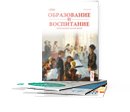TPR and Traditional grammar teaching methods play a votal role in teaching foreign language, especially, English language by providing a number of opportunities to conduct the lesson. TPR enrich lesson process with entertainment by giving more authentic and less stressful learning environment. While traditional methods demonstrate well-structured and rule-focused guidance in order to strengthen the clarity of the material and teaching moment. This article explores the impact of both methods in the context of young learners by highlighting their benefits, challenges and limitations.
Keywords: total physical response, grammar teaching methods, interactive learning process, engagement, foreign language learning, innovative.
Nowadays generation and teaching process is full of new breakthroughs and modern techniques in teaching. Modern methods of teaching, particularly, English teaching methods, are deliberately adapting to new educational actuality. The use of innovative approaches such as the Total Physical Response (TPR) method is in great demand. This method, developed by James Asher, aims to integrate physical activities and language learning, which makes the process of language acquisition more authentic as well as interactive. The method is based on the idea that physical participation in learning makes language anxiety less, enhance student motivation and accelerate process of memorizing language material, especially for younger students of primary school. [1]
Traditional methods of teaching grammar compared to the aforementioned are based on explaining grammatical rules, completing written exercises and applying translation. These methods major goal is an accurate understanding of the structure of the language and the development of academic skills. Traditional methods are known for their effective application, but in spite of this they are often under the criticism for not increasing the communication skills as well as authentic application of language in real-life. [2] Kazakhstani schools and teachers are facing new changes in teaching and learning process by smoothly moving to new methods which are better in ways of being active and engaging. Their main goal is to enhance communication skills along with practical application in real-life situations to involve more authentic patterns. These new methods aim to enhance language skills while fostering intercultural communication. This change reflects the evolving educational standards, which now emphasize critical thinking, creativity, and the capability to learn independently—skills that are essential in today's interconnected world.
In the context of globalization and the growing need for knowledge of foreign languages, especially English, the study and analysis of the effectiveness of modern teaching methods are becoming increasingly relevant. The purpose of this article is a comparative analysis of the TPR method and traditional approaches to teaching grammar in English lessons with an emphasis on their application in the education system of Kazakhstan. [3]
As the main directions and goals of this article, the comparison of the TPR and traditional methods in teaching English grammar can be presented. It tries to explain both of them in details, by highlighting their theoretical and practical foundations in real-life application. Furthermore, by identifying their pros and cons, the article helps to differentiate methods by finding which one works best for the learning process according to the age groups, language levels and specific needs and goals. In addition, one of the essential purposes of this article is to give educators effective as well as useful tools and insights, which will help them to make better decisions while planning their lessons, and build a strong bridge for further investigations on finding creative and relevant new methods. This article holds practical value by providing teachers with practical guidance on integrating the TPR method with traditional approaches to enhance the effectiveness of teaching English grammar. The given strategies are aimed to help teacher how to apply new teaching techniques to engage young learners and develop a number of skills which, as a result, will help to promote their motivation and participation level.
From a scientific perspective, the article offers a comparative evaluation of these methods, deepening insights into English teaching practices. It examines the application of TPR and traditional methods within the context of Kazakhstan’s education system, laying a foundation for future research and encouraging the implementation of innovative instructional techniques in classrooms.
This study implements a qualitative research approach, with the combination of classroom observation and mini-interviews to obtain a broader understanding of how the TPR method and traditional teaching approaches impact on English grammar learning.
Classroom observation was conducted with a group of 15 learners to record teaching practices and student behaviors in a natural setting. Observations mostly focused on student engagement and participation during TPR and traditional grammar lessons each of them separately, teacher-student interactions and communication patterns, effectiveness of grammar explanations and activities, also students' ability to apply grammar knowledge in classroom exercises.
After the lessons short interviews were conducted with learners, with the aim of not scaring them with this new format for them, it was accepted as a reflection that was usual for them. The aim was to collect their feedback on the teaching methods, focusing on their preferences, challenges, and perceived effectiveness. The interview consisted of open-ended questions, such as:
- Which teaching method (TPR or traditional) did you find more helpful for learning grammar? Why?
- How did you feel about participating in physical activities during the lesson?
- What challenges, if any, did you face during the grammar lessons?
- Which activities made grammar easier to understand for you?
The data from both parts were analyzed qualitatively, therefore observational notes were reviewed to identify patterns and trends in teaching practices and learner engagement. Responses from the mini-interviews were grouped into themes to highlight learners' preferences, perceptions of effectiveness, and areas for improvement. The combined data provided a well-rounded view of how TPR and traditional methods impact learning from both an external and internal perspective.
According to the results of observation and responses from learners, it can be analyzed that each method influences on learners learning procedures differently and has its own style and role.
When it comes the engagement and participation part, as a result of several lessons where these two methods implemented separately it represented different engagement levels. During the TPR based lesson, learners were enthusiastically incredibly active, participated in completing exercises by responding noisily, acted out verbs or displayed some grammar structures through movement. For example, in a lesson on «imperative sentences» they actively followed commands like «Touch your nose» or «Jump two times», which also made grammar rules more tangible. During interviews, young learners shared that activities were «funny», «easy to remember» and one of them said «I felt like I’m learning faster because I don’t have to memorize, it’s just happening while we’re playing and that’s it». In contrast, when learners concentrated on traditional methods where they paid more attention on grammar rules explanation by teacher and completed written exercises without any movement it showed less engagement. Even if the majority of the students understood the rules and its usage clearly, but they were not involved, most of them commented like «it was boring», «I wanted to sleep», «The lesson was super long, we only wrote, wrote and wrote» and so on. Through the observation, both of these results and comments can be confirmed, if in the first lesson they were smiling and actively mingling the class, during the second lesson they were passive ones, who even forced to answer teacher’s questions.
The understanding of the grammar topic is the most significant result in applying any method. [4] When the educator explained the prepositions topic through the game «Where’s the object?», the learners reactions and perceptions of the lesson were mixed. During this game the teacher hid objects around the class and gave instrucitons like «Find the pen under the chair» which integrated both listening and action to show their understanding. In this game they learned grammar through experience and continued learning it in pairs. Again it was engaging and fun, but some of them commented that «I am confused», «I couldn’t see the rules when I wanted to use prepositions because I forgot them after doing with the teacher».
But when the teacher used traditional way of explaining the rules where student sat down on their places, followed teacher’s presentation of rules and completed the exercises their comments were strongly positive because the majority of them visual learners and in need for comprehensible input and structured explanation with rules.
In conclusion, the comparative analysis of TPR and traditional grammar teaching methods expose that both of them have the advantages and disadvantages. TPR is considered to be engaging and effective in producing creative and dynamic learning environment, however sometimes can be difficult in explaining complicated topics. When it comes to the traditional methods, they render accurate comprehension, but lack of engagement. Therefore, the choice and effectiveness of teaching approaches primarily depend on the various factors such as special need, learners’ background and so on. [5]
References:
- Astutik Y., Megawati F., Aulina Ch. Total Physical Response (TPR): How is it used to Teach EFL Young Learners // Early Childhood Education Study Program, Universitas Muhammadiyah Sidoarjo, Indonesia. International Journal of Learning, Teaching and Educational Research. 2019. Vol. 18, No. 1, pp. 92–103.
- Semo S., Serroukh I. Traditional Teaching Method vs Modern Teaching Method: The Traditional Way of Teaching and Learning.// GPH-International Journal of Educational Research. 2023. Vol. 6, No. 12.
- Шелестова Т. Ю., Оспанова А. К. Особенности использования программы двустороннего погружения в языковую среду в условиях трехъязычного образования Казахстана // Вестник М. Ауэзова. 2022. № 1. С. 258–263.
- Grado T. Different Methodologies Teaching English // Escuela de Educación de Soria. 2014.
- Fernandes A. The Further Explanation of Total Physical Response (TPR) Method and Direct Method // Teaching English as a Foreign Language (TEFL). 2012. No. 1. P. 13.







